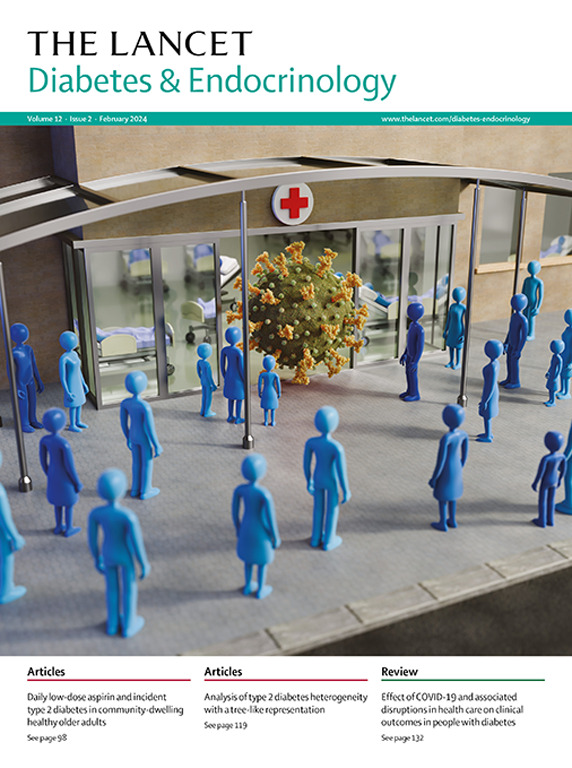Efficacy and safety of once-weekly tirzepatide in Japanese patients with obesity disease (SURMOUNT-J): a multicentre, randomised, double-blind, placebo-controlled phase 3 trial
IF 44
1区 医学
Q1 ENDOCRINOLOGY & METABOLISM
引用次数: 0
Abstract
Background
Data on tirzepatide in Asian patients with obesity are limited. This study aimed to gain a better understanding of tirzepatide for treatment of Japanese patients with obesity disease (BMI ≥25 kg/m2 with excessive fat accumulation) as defined by the Japanese Society for the Study of Obesity.Methods
This was a multicentre, randomised, double-blind, placebo-controlled, phase 3 trial of the efficacy and safety of tirzepatide as an adjunct to lifestyle modifications. Japanese adults with obesity disease (BMI ≥27 kg/m2 accompanied by ≥2 obesity-related health disorders or ≥35 kg/m2 accompanied by ≥1 obesity-related health disorders), excluding diabetes, were assigned 1:1:1 via computer-generated random sequence to receive once weekly subcutaneous tirzepatide (10 mg or 15 mg) or placebo. Coprimary endpoints were the mean percent change in bodyweight and the proportion of participants achieving at least 5% bodyweight reduction at week 72, using the efficacy estimand. Efficacy and safety were assessed in the modified intention-to-treat (mITT) population. This study is registered with ClinicalTrials.gov, NCT04844918.Findings
Between May 10, 2021, and June 24, 2023, 413 participants were screened, and 267 were randomly assigned. Due to exclusion of one study site, the mITT population was 225 participants (133 [59%] men and 92 [41%] women, mean age 50·8 [SD 10·7] years), with 73 in the tirzepatide 10 mg group, 77 in the tirzepatide 15 mg group, and 75 in the placebo group, of whom 192 (85%) completed both study and treatment. Estimated treatment differences relative to placebo in change in bodyweight at week 72 were −16·1% (95% CI −18·7 to −13·5; p<0·0001) and −21·1% (95% CI −23·6 to −18·5; p<0·0001) following tirzepatide 10 mg and 15 mg, respectively. At week 72, a higher proportion of participants achieved at least 5% bodyweight reduction with tirzepatide 10 mg (67 [94%] of 71) and 15 mg (73 [96%] of 76) compared with placebo (15 [20%] of 75; both p<0·0001). Cardiometabolic and body composition indices were also improved with tirzepatide. Participants treated with tirzepatide experienced treatment-emergent adverse events more frequently (10 mg: n=61 [84%]; 15 mg: n=66 [86%]) than those who received placebo (52 [69%]), most commonly gastrointestinal symptoms. Study discontinuations due to adverse events were infrequent (placebo: n=3 [4%]; tirzepatide 10 mg: n=1 [1%]; tirzepatide 15 mg: n=0).Interpretation
In Japanese adults with obesity disease, tirzepatide provided clinically a meaningful reduction in bodyweight compared with placebo over 72 weeks, with a safety profile consistent with that observed in global populations.Funding
Eli Lilly and Company.Translation
For the Japanese translation of the abstract see Supplementary Materials section.一项多中心、随机、双盲、安慰剂对照的3期临床试验:每周一次替西帕肽在日本肥胖患者中的疗效和安全性(SURMOUNT-J
亚洲肥胖患者使用替西肽的数据有限。本研究旨在更好地了解替西帕肽治疗日本肥胖症患者(BMI≥25kg /m2伴有过度脂肪堆积)的疗效。方法:这是一项多中心、随机、双盲、安慰剂对照的3期临床试验,旨在验证替西帕肽作为生活方式改变辅助治疗的有效性和安全性。除糖尿病外,患有肥胖症(BMI≥27 kg/m2伴有≥2种肥胖相关健康障碍或≥35 kg/m2伴有≥1种肥胖相关健康障碍)的日本成年人,通过计算机生成的随机序列按1:1:1分配,接受每周一次皮下替西帕肽(10 mg或15 mg)或安慰剂治疗。主要终点是体重的平均变化百分比和受试者在第72周体重减少至少5%的比例,使用疗效估计。在改良意向治疗(mITT)人群中评估疗效和安全性。本研究已在ClinicalTrials.gov注册,编号NCT04844918。在2021年5月10日至2023年6月24日期间,筛选了413名参与者,随机分配了267名参与者。由于排除了一个研究地点,mITT人群为225名参与者(133[59%]名男性,92[41%]名女性,平均年龄50.8 [SD 10.7]岁),其中替西帕肽10 mg组73人,替西帕肽15 mg组77人,安慰剂组75人,其中192人(85%)完成了研究和治疗。第72周体重变化的估计治疗差异相对于安慰剂为- 16.1% (95% CI为- 18.7至- 13.5;p< 0.0001)和- 21.1% (95% CI为- 23.6至- 18.5;P< 0.0001),替西帕肽分别为10mg和15mg。在第72周,与安慰剂相比,使用替西帕肽10mg(71 / 67[94%])和15mg(76 / 73[96%])达到至少5%体重减轻的参与者比例更高(75 / 15 [20%];术;0·0001)。替西肽也改善了心脏代谢和体成分指标。接受替西肽治疗的参与者更频繁地经历治疗后出现的不良事件(10 mg: n=61 [84%];15 mg: n=66[86%])比安慰剂组(52[69%]),最常见的胃肠道症状。由于不良事件而中断研究的情况很少(安慰剂:n=3 [4%];替西帕肽10 mg: n=1 [1%];替西帕肽15mg: n=0)。解释:在患有肥胖症的日本成年人中,替西帕肽在72周内提供了临床意义上的体重减轻,与安慰剂相比,其安全性与在全球人群中观察到的结果一致。资助礼来公司。摘要的日文翻译见补充资料部分。
本文章由计算机程序翻译,如有差异,请以英文原文为准。
求助全文
约1分钟内获得全文
求助全文
来源期刊

The Lancet Diabetes & Endocrinology
ENDOCRINOLOGY & METABOLISM-
CiteScore
61.50
自引率
1.60%
发文量
371
期刊介绍:
The Lancet Diabetes & Endocrinology, an independent journal with a global perspective and strong clinical focus, features original clinical research, expert reviews, news, and opinion pieces in each monthly issue. Covering topics like diabetes, obesity, nutrition, and more, the journal provides insights into clinical advances and practice-changing research worldwide. It welcomes original research advocating change or shedding light on clinical practice, as well as informative reviews on related topics, especially those with global health importance and relevance to low-income and middle-income countries. The journal publishes various content types, including Articles, Reviews, Comments, Correspondence, Health Policy, and Personal Views, along with Series and Commissions aiming to drive positive change in clinical practice and health policy in diabetes and endocrinology.
 求助内容:
求助内容: 应助结果提醒方式:
应助结果提醒方式:


